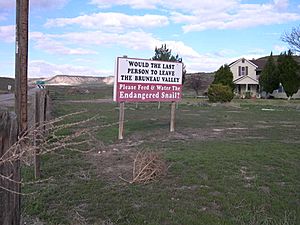Bruneau hot springsnail facts for kids
Quick facts for kids Bruneau hot springsnail |
|
|---|---|
| Conservation status | |
| Scientific classification | |
| Kingdom: | |
| Phylum: | |
| Class: | |
| (unranked): |
clade Caenogastropoda
clade Hypsogastropoda clade Littorinimorpha |
| Superfamily: |
Rissooidea
|
| Family: |
Hydrobiidae
|
| Genus: |
Pyrgulopsis
|
| Species: |
P. bruneauensis
|
| Binomial name | |
| Pyrgulopsis bruneauensis Hershler, 1990
|
|
The Bruneau hot springsnail is a tiny snail that lives in fresh water. Its scientific name is Pyrgulopsis bruneauensis. This snail has a gill and a special lid called an operculum. It is a type of mollusk found only in the Bruneau River area of Idaho, United States. It lives in warm, natural springs. Sadly, its home is disappearing, which puts it in danger.
Contents
What Does It Look Like?
The Bruneau hot springsnail is very small. It is only about 2.2–2.9 millimetres (0.087–0.114 in) tall. That's less than a tenth of an inch! It has a shell that is shaped like a cone or a globe.
Scientists can tell this snail apart from other similar snails. It has unique features on a part of its body called the penial filament.
Where Does It Live?
This special snail is only found in a small area. It lives in warm springs and wet spots. These places are along an 8 kilometres (5.0 mi) stretch of the Bruneau River. This river is located in Southwest Idaho.
Its Home and Why It's in Danger
The Bruneau hot springsnail likes to live on wet rocks. It also prefers areas with flowing water. These areas often have large rocks and boulders.
The biggest danger to this snail is losing its home. People are taking too much water from underground. This water is mainly used for farming. When groundwater levels drop, the warm springs dry up.
The temperature of the spring water is very important. These snails need constant warm water to live. If the temperature changes too much, they cannot survive.
Protecting the Snail
The U.S. Fish and Wildlife Service checks on the Bruneau hot springsnail. In 2007, they said it was still an endangered species. The dangers it faced before are still present today.
- The underground water levels are not stable.
- The number of warm springs where the snail lives is going down.
- The snail populations are shrinking.
- It is harder for different groups of snails to connect.
Even with past efforts, the snail is still in danger of disappearing. But there is some good news! In 2019, Idaho lawmakers made plans to cap many wells. This will help increase the water pressure in the warm springs.
The U.S. Fish and Wildlife Service is working with Idaho. They are also working with landowners and other groups. Their goal is to reduce threats to the snail. They want to help the snail recover so it no longer needs special protection.
Here are some ways they are trying to help:
- They want to increase and stabilize the warm water levels.
- This might include buying water rights from farmers.
- They are also improving irrigation systems. This helps farmers use less water.
- They continue to check water levels and where the snails live.
- They control non-native fish that eat the snails.
- They are working on rules to protect the snail from future water loss.
See also
 In Spanish: Pyrgulopsis bruneauensis para niños
In Spanish: Pyrgulopsis bruneauensis para niños



